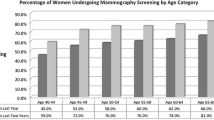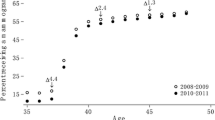ABSTRACT
BACKGROUND
In 2009, the U.S. Preventive Service Task Force changed its recommendation regarding screening mammography in average-risk women aged 40–49 years.
OBJECTIVE
To evaluate the effects of the 2009 recommendation on reported mammogram use in a population-based survey.
DESIGN
Secondary data analysis of data collected in the 2006, 2008, and 2010 Behavioral Risk Factor Surveillance System surveys.
PARTICIPANTS
Women ages 40–74 years in the 50 states and Washington, DC who were not pregnant at time of survey and reported data on mammogram use during the 2006, 2008, or 2010 survey.
MAIN MEASURES
Mammogram use was compared between women ages 40–49 and women ages 50–74 before and after the recommendation. We performed a difference-in-difference estimation adjusted for access to care, education, race, and health status, and stratified analyses by whether women reported having a routine checkup in the prior year.
KEY RESULTS
Reported prevalence of mammogram use in the past year among women ages 40–49 and 50–74 was 53.2 % and 65.2 %, respectively in 2008, and 51.7 % and 62.4 % in 2010. In 2010, mammography use did not significantly decline from 2006–2008 in women ages 40–49 relative to women ages 50–74.
CONCLUSION
There was no reduction in mammography use among younger women in 2010 compared to older women and previous years. Patients and providers may have been hesitant to comply with the 2009 recommendation.


Similar content being viewed by others
REFERENCES
US Preventive Services. Task force. Screening for breast cancer: U.S. preventive services task force recommendation statement. Ann Intern Med. 2009;151:716–726.
Nelson HD, Tyne K, Naik A, et al. Screening for breast cancer: Systematic evidence review update for the U.S. Preventive Services Task Force. Evidence review update. Rockville: Agency for Healthcare Research and Quality; 2009.
Nelson HD, Tyne K, Naik A, et al. Screening for breast cancer: an update for the U.S. Preventive services task force. Ann Intern Med. 2009;151:727–37.
Kalager M, Adami HO, Bretthauer M, Tamimi RM. Overdiagnosis of invasive breast cancer due to mammography screening: results from the Norwegian screening program. Ann Int Med. 2012;156(7):491–9.
Partridge AH, Winer EP. On mammography—more agreement than disagreement. N Engl J Med. 2009;361:2499–501.
DeAngelis CD, Fontanarosa PB. U.S. preventive services task force and breast cancer screening. JAMA. 2010;303(2):173–4.
Squiers LB, Holden DJ, Dolina SE, et al. The public’s response to the U.S. preventive services task force’s 2009 recommendations on mammography screening. Am J Prev Med. 2010;40(5):497–504.
Davidson AS, Liao X, Magee D. Attitudes of women in their forties toward the 2009 USPSTF mammogram guidelines: a randomized trial on the effects of media exposure. Am J Obstet Gynecol. 2011;205:e1–7.
American Cancer Society. American Cancer Society guidelines for the early detection of cancer. www.cancer.org/Healthy/FindCancerEarly/CancerScreeningGuidelines/american-cancer-society-guidelines-for-the-early-detection-of-cancer. Accessed April 21, 2013.
Hinz EK, Kudesia R, Rolston R, et al. Physician knowledge of and adherence to the revised breast cancer screening guidelines by the U.S. preventive services. Task Force. Am J Obstet Gynecol. 2011;205:201. e1-5.
Miller JW, King JB, Ryerson AB, et al. Mammography use from 2000–6: state-level trends with corresponding breast cancer incidence rates. Am J Roentology. 2009;192:352–60.
Ryerson AB, Miller JQ, Eheman CR, et al. Recent trends in U.S. mammography use from 2000–6: a population-based analysis. Prev Med. 2008;47:477–82.
Centers for Disease Control and Prevention (CDC). Cancer Screening- United States, 2010. Morbidity and Mortality Weekly Reports. 2012. http://www.cdc.gov/mmwr/preview/mmwrhtml/mm6103a1.htm. Accessed May 1, 2013.
Meissner HI, Klabunde CN, Han PK, et al. Breast cancer screening beliefs, recommendations, and practices. Cancer. 2011;117:3101–11.
Bellizzi KM, Breslau ES, Burness A, et al. Prevalence of cancer screening in older and racially diverse adults. Arch Intern Med. 2011;171(22):2031–37.
Pace LE, He Y, Keating NL. Trends in mammography screening rates after publication of the 2009 US Preventive Services Task Force recommendations. Cancer. 2013. doi:10.1002/cncr.28105.
Centers for Disease Control and Prevention (CDC). Behavioral Risk Factor Surveillance System Survey Questionnaire. Atlanta, Georgia: U.S. Department of Health and Human Services, Centers for Disease Control and Prevention, 2006, 2008, and 2010.
Nelson DE, Holtzman D, Bolen J, Stanwyck CA, Mack KA. Reliability and validity of measures from the Behavioral Risk Factor Surveillance System (BRFSS). Soc Prev Med. 2001;46:S03–S42.
Caplan LS, McQueen DV, Qualters JR, Leff M, Garrett C, Calonge N. Validity of women’s self-reports of cancer screening test utilization in a managed care population. Cancer Epidemiol Biomark Prev. 2003;12:1182.
Behavioral Risk Factor Surveillance Survey. 2011 survey data information: Comparability of data. CDC. 2011. http://www.cdc.gov/brfss/annual_data/annual_2011.htm. Accessed April 21, 2013.
Lambrew JM, Defriese GH, Carey TS, Ricketts TC, Biddle AK. The effects of having a regular doctor on access to primary care. Med Care. 1996;34(2):138–51.
Shoen C, DesRoches C. Uninsured and unstably insured: the importance of continuous insurance coverage. Health Serv Res. 2000;35(1):187–203.
Bertrand M, Duflo E, Mullainathan S. How much should we trust difference-in-differences estimates? Q J Econ. 2004;119(1):249–75.
Norton EC, Wang H, Ai C. Computing interaction effects and standard errors in logit and probit models. Stata J. 2004;4(2):154–67.
Volpp KG, Rosen AK, Rosenbaum PR, et al. Mortality among medicare beneficiaries in the first two years following ACGME resident duty hour reform. JAMA. 2007;298(9):975–83.
Karaca-Mandic P, Norton EC, Dowd B. Interaction terms in nonlinear models. Health Serv Res. 2012;47(1):255–274.
Centers for Disease Control and Prevention (CDC). BRFSS Weighting Formula. Atlanta, Georgia: U.S. Department of Health and Human Services, Centers for Disease Control and Prevention. http://www.cdc.gov/brfss/annual_data/2010/2010_weighting.htm. Accessed April 21, 2013.
Nutting PA, Baier M, Werner JJ, Cutter G, Conry C, Stewart L. Competing demands in the office visit: what influences mammography recommendations. J Am Board Fam Pract. 2001;14:352–61.
Lu P, Bridges CB, Euler GL, Singleton JA. Influenza vaccination of recommended adult populations, United States, 1989–2005. Vaccine. 2008;26(14):1786–93.
Smith RA, Cokkinides V, Brookes D, Saslow D, Brawley OW. Cancer screening in the United States, 2010: a review of current American cancer society guidelines and issues in cancer screening. CA Cancer J Clin. 2010;60(2):99–119.
Meissner HI, Breen N, Klabunde CN, Vernon SW. Patterns of colorectal cancer screening uptake among men and women in the United States. Cancer Epidemiol Biomark Prev. 2006;15(2):389–94.
Zelaidt SB, Hoffman RM, Etzioni R, et al. Influence of publication of US and European prostate cancer screening trials on PSA testing practices. J Natl Cancer Inst. 2011;103:520–3.
Feldman S. Making sense of the new cervical cancer screening guidelines. N Engl J Med. 2011;365:2145–47.
Solomon D, Breen N, McNeel T. Cervical cancer screening rates in the United States and the potential impact of implementation of screening guidelines. CA Cancer J Clin. 2007;57(2):105–11.
Rauscher GH, Johnson TP, Cho YI, et al. Accuracy of self-reported cancer-screening histories: a meta-analysis. Cancer Epidemiol Biomark Prev. 2008;17:748–57.
Craig BM, Quinn GP, Vadaparampil ST. Sensitivity of self-report mammography use in older women. Am J Prev Med. 2009;37(5):441–4.
Elmore JG, Barton MB, Moceri VM, Polk S, Arena PJ, Fletcher SW. Ten-year risk of false positive screening mammograms and clinical breast examinations. N Engl J Med. 1998;338:1089–96.
Acknowledgements
Funding
None.
Prior presentations
Presented as a poster at the AcademyHealth Annual Research Meeting on June 26, 2012.
Conflict of Interest
The authors declare that they do not have any conflicts of interest.
Author information
Authors and Affiliations
Corresponding author
Appendix
Appendix
Rights and permissions
About this article
Cite this article
Block, L.D., Jarlenski, M.P., Wu, A.W. et al. Mammography Use Among Women Ages 40–49 After the 2009 U.S. Preventive Services Task Force Recommendation. J GEN INTERN MED 28, 1447–1453 (2013). https://doi.org/10.1007/s11606-013-2482-5
Received:
Revised:
Accepted:
Published:
Issue Date:
DOI: https://doi.org/10.1007/s11606-013-2482-5




